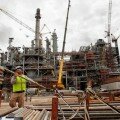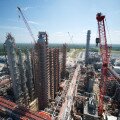On June 19th Mississippi Business Journal’s publisher Alan Turner visited Mississippi Power’s Kemper Plant to get an “up close and personal” view of the plant and how it works. Turner questioned Assistant Kemper Plant Manager Bruce Harrington about how the Kemper Plant will “produce electricity that is comparable to natural gas plants in terms of cleanliness and emissions.” Harrington stated “All of this has been done before. We’re just bringing the various elements together in one place. “This is clean energy. It will enable us to balance our energy production among various fuels, and ultimately, allow us to be more efficient in the production of electricity.” Harrington pointed out that the company is making investments in wind, solar, and nuclear power, so that a clean plant such as Kemper is just one more cog in a big wheel. There are a number of important reasons why we felt Kemper was the right way to go. Among those, was the need to build a plant in a somewhat safer environment, because we learned first-hand that a hurricane, such as Katrina, can wreak havoc on power plants.” Harrington also pointed out that since the fuel source is right there, and the price of that fuel will be a known stable factor, that Kemper will help to shield its ratepayers from potentially volatile fluctuations in fuel cost. “Right now, natural gas is priced very low. Oil has shown the kind of up and down volatility that makes it difficult to predict your costs a year or two down the road. But for sure, none of us knows what kind of cost volatility we may see in coming years. Things can change overnight, based on events that happen in other parts of the world. Kemper is insulated from that sort of fluctuation,” he said. He pointed to the abundance of lignite as another reason why the plant makes sense. “There is a lignite strain running all the way from west Tennessee, through Mississippi, and into southeast Alabama,” he said. “All told, you’re looking at over 400 billion tons in that strain. In its useful operating life, Kemper will probably use no more than 180 million tons of that resource.” “We don’t burn coal here,” he said. Instead, we extract the gases from the lignite and turn it into usable syngas. That allows us to capture the CO2 and prevent it from going up the stack. There you have clean energy.”
Kemper will derive a number of valuable industrial chemicals, including sulphuric acid (very important in paper production), ammonia (important in making fertilizer), and others. Once in full production, the estimate is that the value of those chemicals on the market could range anywhere between $50 and $100 million per year. “That will obviously benefit our customers,” Harrington said. Despite controversy, Harrington suggested that Mississippi has seen significant benefits from its construction! “For instance, Kemper contributed to over 12,000 direct and indirect jobs”, Communications Manager Lee Youngblood said. “Over 500 Mississippi companies worked on the project. We paid more than $75 million in state and local taxes, and we’ll pay $30 million in state and local taxes when the plant is fully operational. And let’s not forget Kemper County. The plant will contribute more than $13 million a year to this county, which only has 12,000 residents. That’s a substantial impact. Looking at the recent news, in which Mississippi was one of only 2 states that had negative economic growth last year, it does make you wonder how that would have looked without Kemper.”
After Turner met with Kemper Plant officials, they put on their hard hats, vests, and eyewear protection and took the tour! According to Turner, they “ascended in a cage elevator to near the top of the main project and got a great birdseye view of the entire facility, from the coal mine to the various elements of the plant itself. It was an impressive sight!”
From there, Turner visited the coal mine to learn how that works. They spent some time with Matt Jones, Engineering and Operations Manager with North American Coal Corporation, which actually handles the mining and land reclamation. Once in full production, the mining operation will employ 250-300 people (the Kemper plan itself will have 500 permanent jobs), and “that’s a significant payroll impact for this area”. The mine operates on leased land, which benefits the landowner. More importantly, Jones said that “the land restoration begins as soon as we’ve mined a specific area.” Jones showed Turner the current mining pit (the coal is fairly shallow, ranging from 10-120 feet in depth), and right next to that, land that had been restored to its previous state. The difference was striking. “This is an ongoing process,” he said. “We are regularly inspected to verify that we’re reclaiming the land effectively and efficiently.” In full operation, the plant will consume approximately 700 tons of coal per hour, and will produce up to 585 megawatts of energy!
According to Turner, he was surprised that Kemper is currently producing electricity using natural gas and is delivering electricity into the grid! Turner said “It was an interesting visit!”
See Turner’s article here! There is also a video of Turner’s Kemper Plant tour on You Tube!





 #Kemper is capable of producing much cleaner energy from coal, that’s why energy leaders are watching so closely.
#Kemper is capable of producing much cleaner energy from coal, that’s why energy leaders are watching so closely.